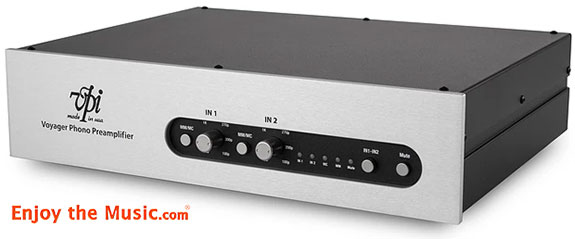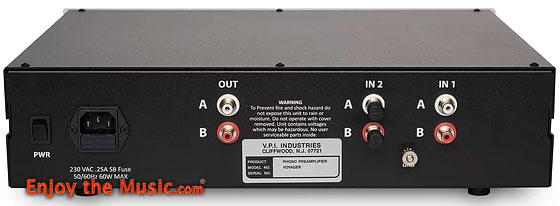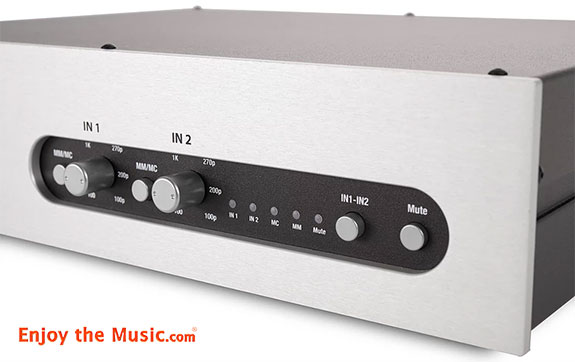
VPI’s new MM / MC phono stage delivers a spatially refined, detailed, and realistic musical performance. Review By Ron Nagle

Compact disc recording became a reality in 1982 and the Sony Corporation advertised “Perfect Sound Forever”. And so vinyl LP recordings were destined to die a slow death. Or was it? Indeed production of new music on black plastic slowly slipped away as digits did the dirty deed. Many an audiophile rode the ‘wave of the future’ and many an audiophile turned analog into digital audio-files. And this brings us to my World Premiere review of VPI Industries’ Voyager phono amplifier.
Personally, there’s a certain metallic tincture to that vaunted digital medium. The phrase I coined back then was “Aluminum Violins”, and inevitably aligned myself with Absolute Sound publisher Harry Pearson. It seemed back then that both of us smelled a rat with the new CD format. But at the inception, who then would have thought a tiny stone scraping along a plastic groove could recall so many pleasant memories. You could go back in time at some point and consider the VPI Voyager vinyl LP turntable as a time machine helping to transport us to a better place.
Back Story VPI Industries was founded in 1978 by Harry and Sheila Weisfeld. Their first product was a record weight in two different sizes. That same year in December they introduced another product, a turntable isolation base. However, it was the introduction in 1981 of the VPI 16 record cleaning machine that placed the firm on solid economic ground. Not so incidentally, 2018 marks the company’s 40th anniversary. Today, the company’s day to day operations have been handed down to son and company President Mathew Weisfeld. This leaves Founding Father Harry Weisfeld the freedom to be the creative mind that drives product development.
OK, we need to have a talk, about the bolts of the body main and things around the back.

Voyager Genesis In 2017 Harry Weisfeld hired an Electronic Engineer named Mike Bettinger. He admired Mr. Bettinger’s award winning Arion Amplifier so much that he purchased that amplifier for his personal use. The Voyager Phono Amplifier is the high performance device that evolved from this collaboration. It has two independent phono inputs, so it can accommodate two different cartridges if mounted on separate tonearms. This makes switching between two tonearms and two cartridges very easy. It provides both Moving Magnet and Moving Coil cartridge amplification along with variable cartridge loading. As you would suspect all of this is housed in a black metal box. The dimensions measure 15.5″ x 13″ x 4.5″ (WxDxH) and shipping weight is 10.5 lbs. The face panel is available with a black finish or the standard matte aluminum. The amplifier’s front panel has an oblong opening exposing a second panel. All gain and load and input settings are made using controls in this sub-panel. Within this recess are two push buttons labeled input 1 and input 2. These push buttons will select either Moving Coil or Moving Magnet cartridge amplification. Internally, gain and loading are accomplished using high reliability small signal relays.
Up front there are two larger knobs that can serve two functions. Each can select cartridge loading resistance in Ohms or in Pico farads. They allow loading for input 1 or input 2. That might be for either a moving magnet (MM) or moving coil (MC) cartridge. The standard 47 kOhm load for MM cartridges is built in and not variable. If you chose the MM input then capacitive loading is select-able. You can apply, 100pF, 200pF or 270pF. The MC cartridge resistive load is select-able between 100 Ohm, 500 Ohm and 1 kOhm. Gain is fixed at 42dB (MM) and 62dB (MC). There are five indication LEDs on the front panel. Left to right they are, input 1, input 2, MM, MC, and Mute. On the right are two push buttons to select, MM / MC or Mute.
Around back: All the input and output connections are single ended RCA jacks, six in total. Two are for left/ right phono input 1 and two jacks for input 2; the last pair of RCA connections is the Voyager output to a power amplifier. Lastly there is chassis ground lug and the IEC Mains connection.

Circuit Implementation The VPI Voyager is a two-stage design, The first stage utilizes a JET-based input stage providing the interface with the cartridge, and the gain and drive for the 75 microseconds. Also, passive equalization network for the high-frequency RIAA equalization is employed. The design is intentionally symmetrical and single-ended. Both stages are based on precision matched cascoded Linear Systems JFETS that are servo controlled. Cascode references are supplied by precision low noise reference devices. The second stage provides an additional 24dB of gain plus provides active feedback for tracking the low-frequency portion of the RIAA curve. The power supplies are unity gain voltage reference designs that facilitate fast response and low noise.
Cut To The Chase… The Sound
Let me take this in two parts the Voyager has two separate inputs. First at Input #1, that’s my Ortofon 2M Silver (silver wire) MM cartridge with 5.5 mV out into a 200pF load.
Instead of mentioning all the mediocre vinyl records listened to during this review, I’ll focus on only one really good representative album and a single track for both cartridges. An early mint pressing Gaucho by Steely Dan [MCA 6102] side A the second track “Hey Nineteen”. Unexpectedly, and right out of the preamp packing, you hear attention grabbing dynamiccontrasts that impart a sense of pace and excitement. I crank up the volume and the recording has me singing along repeating a phrase. The sound between my loudspeakers is very three-dimensional, with imaging being both wide and deep. The personal effect is hard to describe yet very convincing. If you will imagine watching a meteor shower on a dead black night, you might unexpectedly see very brief flashes of light. There is a similar effect like a single note from a plucked steel guitar string. It lasts a split second, and then it is gone. It emerges out of a black space between my speakers as if by magic. I am describing a very fast transient sound from a very silent electronic background.

Also want to mention one odd finding. Switching capacitive loading of the MM Ortofon 2M cartridge between 100 pico farads and 200 pf causes a large shift of the relative amounts of bass and treble. The frequency change is to a greater degree than any phono amplifier in my experience. As a matter of fact, it almost functions like a tone control. Increasing cartridge loading from 100 pf to 200 pf produced a frequency shift upward that enhanced the mid-range and treble frequencies. Conversely, at 100 pf there was more of an emphasis on bass.
Input #2, Denon 103. MC Cartridge 0.3mV @ 100 Ohms This Denon 103 cartridge is probably the most ubiquitous moving coil (MC) ever made. Let’s duplicate that first go round, back to the Steely Dan recording “Hey Nineteen.” Once again a delightful wide open window on the performance. Imaging is open laterally but image depth not quite as deep as my reference six valve Tavish phono stage. If ever you read a description referring to “music layered over a black background”, then this is partially due to the amplifier’s electronic circuit’s noise level. This would be more noticeable with a low output MC cartridge. Here’s where the analog experts at VPI mentioned to me more than once, as they are justifiably proud it is actually dead quiet. Once again, the Voyager transient speed imparts a real sense of excitement. The Denon103 cartridge has a deeper more defined bass response than my Ortofon Silver 2M MM cartridge this adds a greater sense of power displayed on a broad scale.

Conclusion Ultimately, the results you get from your high-end audio system are influenced by many factors. It is the legendary computer programmer’s axiom about GI = GO, meaning garbage in then garbage out. Fortunately, my job was made very easy due to the strong character of VPI’s Voyager turntable being hard to ignore. This is high-tech solid-state, fast and quiet. All at once (with the right material) portraying a spatially refined, detailed, and realistic performance. If you were to survey all the phono amplifiers within the market place, you would find that VPI’s Voyager price is very reasonable and approximates the mid-scale in value. If you have a collection of vinyl LPs or are on your way to building one, my advice is to buy VPI Industries’ Voyager turntable. There are many wonderful things to love! You might be surprised just how far today’s phono amplifiers have evolved too. The last step in the acquisition process might be to convince the household Minister of Finance of the value proposition. It is well worth it!
Enjoy the music and from me, Semper Hi-Fi!
| Tonality |     |
| Sub–bass (10Hz – 60Hz) |    |
| Mid–bass (80Hz – 200Hz) |     |
| Midrange (200Hz – 3,000Hz) |      |
| High Frequencies (3,000Hz On Up) |     |
| Attack |    |
| Decay |     |
| Inner Resolution |      |
| Soundscape Width Front |     |
| Soundscape Width Rear |      |
| Soundscape Depth Behind Speakers |      |
| Soundscape Extension Into Room |     |
| Imaging |      |
| Fit And Finish |     |
| Self Noise |      |
| Value For The Money |     |
Specifications Type: Solid-state stereo moving magnet and moving coil phono stage
Frequency Response: 20Hz to 20kHz (+/- 0.2 dB)
Harmonic Distortion: <0.005% @ 20kHz
Signal To Noise Ratio (MM): 85 dB, input shorted, IHF A-weighted
Signal To Noise Ratio (MC): 74 dB, input shorted, IHF A-weighted
Crosstalk: 75 dB @ 1kHz
Phono Impedance: MM fixed setting, 47 kOhm, MC setting: Selectable
Output Impedance: Unbalanced < 100 Ohm
Input Sensitivity @ 1 kHz: MM 5mV in for 1.0 Volt out. MC 0.5 mVolt for 1 Volt out
Gain: MM = 42dB and MC = 62dB
AC Voltage: Factory adjustable 115 or 230 VAC 50-60 Hz
Dimensions: 15.5″ x 13″ x 4.5″ (WxDxH)
Weight: 10.5 lbs.
Serial number: 16-0010
Price: $2500
Company Information
VPI Industries
77 Cliffwood Ave. #5D
Cliffwood N.J. 07721
Voice: (732) 583-6895
E-mail: info@vpiindustries.com
Website: www.VPIindustries.com















Want to join discussion?
Feel free to contribute!